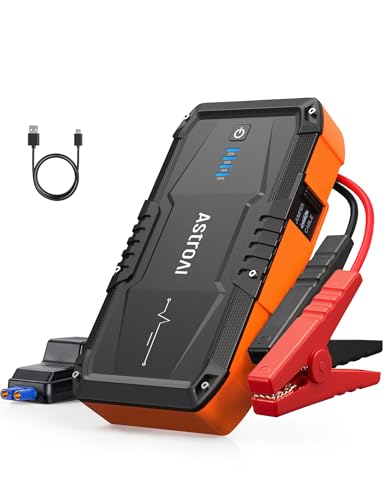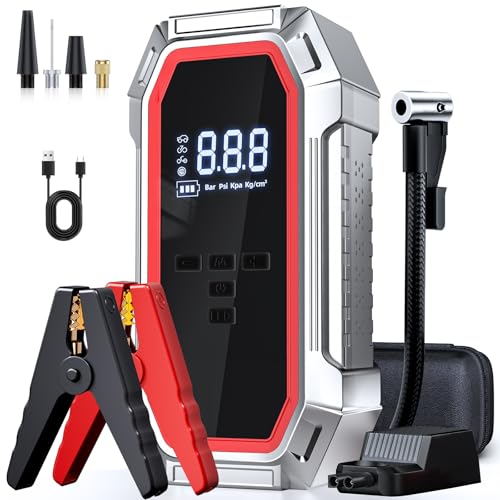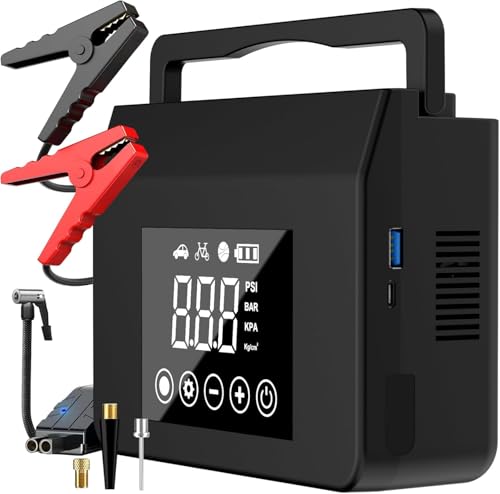You’re stranded with a dead car battery, and a helpful stranger has just given you a jump start. The engine is running, but a new question immediately pops into your mind: now what? You’re wondering if you can just turn it off, or if there’s a specific amount of time you need to wait. Knowing the correct next step is crucial to avoid being stranded again just a few minutes later.
After a successful jump start, it is recommended to drive your vehicle for a minimum of 20-30 minutes. This allows the alternator enough time to sufficiently recharge the battery for a reliable next start.
Leveraging extensive analysis of available data and established automotive best practices, this guide unpacks the precise steps to take after a jump start. We will cover why this run time is critical, the factors that can change it, and how to troubleshoot deeper issues. This guide provides the critical insights you need to effectively navigate a dead battery situation and prevent it from happening again.
Key Facts
- Standard Recharge Time: The consensus among automotive experts is that a 20 to 30-minute drive is the minimum required for the alternator to adequately replenish a car battery’s charge after a jump.
- Driving Beats Idling: Driving is significantly more effective than idling for recharging. The engine’s higher RPMs while driving allow the alternator to produce more electricity, charging the battery more efficiently.
- Battery Lifespan is Limited: Most car batteries have a typical lifespan of three to six years. A battery older than this may struggle to hold a charge, even after a long drive.
- Healthy Voltage Ranges: According to diagnostic data, a healthy, fully charged car battery should have a resting voltage between 12.2 and 12.6 volts. When the engine is running (idling), this should increase to between 14 and 14.5 volts, indicating the alternator is working correctly.
- Jump Start is a Temporary Fix: A jump start only provides enough electrical power to start the engine. It does not recharge the battery; that is the job of the car’s alternator once the engine is running.
The Quick Answer: How Long to Run Your Car After a Jump Start
After a jump start, drive your car for a minimum of 20-30 minutes. This allows the alternator enough time to replenish the battery’s charge for a reliable next start. This recommendation is the generally accepted best practice based on expert consensus and the operational mechanics of a vehicle’s charging system.

Here’s a quick breakdown of the essential timeframes:
- Minimum Recommendation: A 20 to 30-minute drive at normal speeds is the baseline.
- Completely Dead Battery: If the battery was fully drained, you might need to drive for an hour or more to achieve a substantial charge.
- Idling Is Not Ideal: If you can’t drive, letting the car idle for the same amount of time is a less effective alternative, but it’s better than shutting it off immediately.
Quick Fact: A jump start only provides enough power to start the engine, not to recharge the battery. The real work begins after the car is running.
Why Your Car Needs to Keep Running After a Jump
A jump start is only a temporary boost to start the engine. The alternator, powered by the running engine, is what actually recharges the battery for future use. Understanding the difference between these two processes is key to avoiding a repeat dead battery.
When you connect jumper cables, you’re essentially borrowing power from a donor vehicle’s battery to give your starter motor the jolt it needs to turn over the engine. Once your engine is running, the jump start’s job is done. At this point, your car’s own electrical system takes over. The alternator, which is a small generator connected to the engine’s crankshaft via a belt, begins to produce electrical current. This current powers all your car’s electronics (lights, radio, A/C) and, crucially, sends excess power back to the battery to recharge it.
Think of a jump start like a defibrillator for your car’s heart—it gets it started, but the alternator is the exercise that makes it strong again.
A jump start provides just enough power to get the engine running but does not fully recharge a depleted battery. The primary reason to keep the car running after a jump is to allow the alternator, a component connected to the engine, to generate electricity and replenish the battery’s charge.
Factors That Affect Battery Recharge Time
The 20-30 minute rule is a great starting point, but several variables can influence how long you actually need to drive. Is your battery older than three years? If so, you may need to lean towards the longer end of that 30-minute drive. Consider these factors to assess your specific situation.
- Battery Condition and Age: An older or weakened battery won’t hold a charge as effectively. Most car batteries last between three to six years. If your battery is nearing the end of that lifespan or is damaged, it will take longer to recharge and may fail to hold that charge for long.
- Degree of Discharge: A battery that was only slightly drained (perhaps from leaving an interior light on for an hour) will recharge much faster than one that was completely dead. A fully discharged battery may require an hour or more of driving to get a reliable charge.
- Driving vs. Idling: As we’ll cover in more detail below, driving is far superior to idling. The higher engine speed during a drive allows the alternator to work at its peak efficiency.
- Alternator Performance: The entire charging process depends on a healthy alternator. If this component is failing, the battery won’t recharge properly, no matter how long you drive. This often leads to repeated dead battery issues.
- Electrical Load: Your alternator has to power everything in the car. If you’re running the air conditioning on full blast, have your headlights on, and are listening to the radio, you’re diverting power that could otherwise be going to the battery. Turning off non-essential accessories helps speed up the charging process.
Driving vs. Idling: Why a Short Trip is Better Than Sitting Still
Driving at normal speeds charges a battery faster than idling because higher engine RPMs allow the alternator to generate significantly more power. While letting the car idle in your driveway is better than nothing, a short trip around the neighborhood is the most effective strategy.
The alternator’s electricity production is directly tied to the speed of the engine, measured in RPMs (Revolutions Per Minute). At idle, your engine might be turning at 600-800 RPMs. While driving, it’s typically between 1,500 and 3,000 RPMs. This significant increase in engine speed spins the alternator much faster, resulting in a higher electrical output and a quicker, more efficient charge for your battery.
Here’s a direct comparison:
| Feature | Driving | Idling |
|---|---|---|
| Engine RPMs | Higher (1500-3000+) | Lower (600-800) |
| Alternator Output | More Efficient / Higher Wattage | Less Efficient / Lower Wattage |
| Time to Charge | Shorter | Longer |
Pro Tip: To maximize charging efficiency, turn off non-essential accessories like the radio, A/C, and interior lights during your post-jump drive. This allows the alternator to dedicate more of its power to replenishing the battery.
How to Safely Jump Start Your Car: A Step-by-Step Guide
Before you can worry about how long to leave car running after jump, you need to perform the jump start correctly and safely. Following the proper procedure is essential to protect yourself and your vehicle’s electronics.
Safety First: Always wear eye protection, like wrap-around safety glasses, when working with car batteries. Batteries can release flammable hydrogen gas, and a spark can cause an explosion. Ensure both cars are turned off with their parking brakes engaged before you begin.
Here is the standard, manufacturer-recommended safe procedure for jump-starting a car:
- Position the Vehicles: Park the car with the good battery (the “donor” vehicle) close to the car with the dead battery, but do not let the vehicles touch. They can be nose-to-nose or side-by-side, as long as the jumper cables can comfortably reach both batteries.
- Locate Battery Terminals: Open the hoods and identify the positive (+) and negative (-) terminals on both batteries. The positive terminal is almost always marked in red and may have a plastic cover, while the negative is marked in black.
- Connect the Red (Positive) Cable: Attach one of the red clamps to the positive (+) terminal of the dead battery. Then, attach the other red clamp to the positive (+) terminal of the donor battery.
- Connect the Black (Negative) Cable: Attach one of the black clamps to the negative (-) terminal of the donor battery.
- Ground the Final Connection: Attach the final black clamp to an unpainted metal surface on the car with the dead battery. A bolt on the engine block or the vehicle’s frame is a good spot. Do NOT connect the last clamp to the negative terminal of the dead battery. This is the most crucial safety step, as it grounds the circuit and prevents sparks from occurring near the battery itself.
- Start the Donor Vehicle: Start the engine of the donor car and let it run for a few minutes. Some sources recommend waiting 10-15 minutes to allow a preliminary charge to build in the dead battery.
- Start the Dead Vehicle: Attempt to start the car with the dead battery. If it starts, you’re ready for the next step. If not, wait a few more minutes with the donor car running and try again.
- Disconnect the Cables (Reverse Order): Once the jumped car is running smoothly, remove the cables in the exact reverse order you connected them. This is critical to prevent electrical surges.
- Remove the black clamp from the grounded metal surface.
- Remove the black clamp from the donor battery.
- Remove the red clamp from the donor battery.
- Remove the red clamp from the jumped car’s battery.
- Keep the Engine Running: Now, begin the crucial 20-30 minute drive to allow your alternator to recharge your battery.
Troubleshooting: What if the Car Dies Again After the Jump?
If your car dies again after a 30-minute drive, you likely have a bad battery that can’t hold a charge or a failing alternator that isn’t charging it. A jump start is a fix for a drained battery, not a broken one. If the problem reappears shortly after your recharge drive, it’s a clear sign of a more serious underlying issue.
Do any of these symptoms sound familiar? If so, the issue is likely more than just a drained battery.
- The car won’t stay running: If the engine dies as soon as you disconnect the jumper cables, or shortly after, it’s a strong indicator of a faulty alternator that isn’t producing enough power to run the car on its own.
- Dimming lights and slow electronics: When you rev the engine, do your headlights get brighter? This can be a sign that the alternator is weak and can’t provide consistent power at idle.
- Repeatedly dead battery: If you find your battery dead every morning, even after a long drive the day before, the battery itself is likely old or damaged and can no longer hold a charge.
- Clicking noise when starting: A rapid clicking sound when you turn the key often means the battery has enough power to engage the starter solenoid but not enough to turn the engine over—a classic symptom of a dead battery.
- Rotten egg smell: A pungent, sulfurous odor around the battery indicates it is leaking and has likely suffered an internal short. This is a dangerous condition, and the battery should be replaced immediately.

If you experience any of these issues, it is highly advisable to have your vehicle inspected by a professional mechanic. They can properly test the battery, alternator, and the rest of the charging system to pinpoint the exact cause of the problem.
Proactive Care: How to Maintain Your Car Battery’s Health
The best way to deal with a dead battery is to prevent it from happening in the first place. By taking a few simple, proactive steps, you can maximize your battery’s lifespan and reliability, helping you avoid the need for a jump start altogether.
- Drive Regularly: Cars are meant to be driven. Letting a car sit for weeks at a time is a common cause of battery drain. Short, regular drives (even just 20-30 minutes) are enough to keep the battery topped up.
- Use a Trickle Charger for Storage: If you know you won’t be driving your car for an extended period, a trickle charger (or battery tender) is an excellent investment. This device provides a slow, steady stream of power to keep the battery at its optimal charge level without overcharging it.
- Check the Age: Keep track of your battery’s age. As mentioned, most last 3-6 years. If yours is approaching or has passed the three-year mark, have it professionally tested during your next oil change to assess its health.
- Keep Terminals Clean: Corrosion on the battery terminals can impede the flow of electricity. Periodically check them and clean off any white or blueish powder with a wire brush and a mixture of baking soda and water.
- Test the Voltage: You can monitor your battery’s health with a simple multimeter. A healthy battery should show a resting voltage of 12.2-12.6 volts. When the car is idling, the voltage should read between 14-14.5 volts, which confirms the alternator is charging correctly.
To make this proactive maintenance easier, consider investing in a reliable jump starter or a smart battery charger. Having one in your trunk provides peace of mind and can save you from being stranded.
FAQs About Running a Car After a Jump Start
Can you drive a car right after a jump start?
Yes, not only can you drive it, you absolutely should. Driving the car for 20-30 minutes immediately after a successful jump start is the most effective way to allow the alternator to recharge the battery.
How long should I leave jumper cables on after the car starts?
You should disconnect the jumper cables immediately after the car with the dead battery has started and is running smoothly. Leaving them connected is unnecessary and can pose an electrical risk. Always remove them in the exact reverse order you connected them.
Does revving the engine charge the battery faster when jumping?
Revving the donor car’s engine slightly while connected can provide a small boost of power to help start the dead car. However, once the dead car is running on its own, revving it in place is not an efficient way to charge the battery. A steady drive at normal speeds is much more effective.
Is it better to let the car idle or to drive it to charge the battery?
It is always better to drive the car. Driving keeps the engine at higher RPMs, which allows the alternator to produce more electricity and charge the battery much faster and more efficiently than idling does.
Do I need to replace my battery after just one jump start?
Not necessarily. A single jump start could be needed for a simple reason, like leaving your headlights on. However, if the battery is over three years old or if it continues to die repeatedly, it is a strong sign that it needs to be tested and likely replaced.
How long does it take to charge a car battery by idling?
Charging a car battery by idling is very inefficient and can take a significantly long time, potentially several hours for a substantial charge. Driving for 30 minutes is far more effective than idling for an hour or more, as the alternator produces much less power at idle RPMs.
Final Summary: Key Takeaways for After a Jump Start
Navigating a dead battery situation can be stressful, but knowing what to do after the engine is running again makes all the difference. The jump start is just the first step; the recharge drive is what truly gets you back on the road reliably. By understanding the roles of the battery and alternator, you can handle this common issue with confidence.
Now that you’re equipped with this knowledge, you can handle a dead battery with confidence. If your battery is over three years old, consider getting it tested professionally to avoid being stranded again.
- Drive for 20-30 Minutes: This is the most critical step. After a successful jump, drive your car at normal speeds for at least 20-30 minutes to let the alternator do its job and recharge the battery.
- Driving is Superior to Idling: A real drive is always the best option. Higher engine RPMs mean a faster, more efficient charge. Idling should only be a last resort.
- A Jump Is Not a Permanent Fix: A jump start revives a drained battery but cannot fix a faulty one. If the problem persists, the issue is likely your battery or alternator.
- Troubleshoot Persistent Problems: If the car dies again, look for signs of a failing battery (over 3 years old, corrosion) or a bad alternator (dimming lights, dying at idle) and seek professional diagnosis.
Last update on 2025-10-08 / Affiliate links / Images from Amazon Product Advertising API













